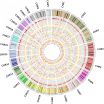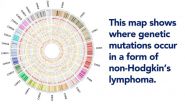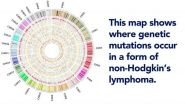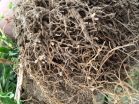(Press-News.org) NEW YORK, NY (April 14, 2015) -- The first-ever systematic study of the genomes of patients with ALK-negative anaplastic large cell lymphoma (ALCL), a particularly aggressive form of non-Hodgkin's lymphoma, shows that many cases of the disease are driven by alterations in the JAK/STAT3 cell signaling pathway. The study also demonstrates, in mice implanted with human-derived ALCL tumors, that the disease can be inhibited by compounds that target this pathway, raising hopes that more effective treatments might soon be developed. The study, led by researchers at Columbia University Medical Center (CUMC) and Weill Cornell Medical College, was published today in the online edition of Cancer Cell.
"Current therapies for this form of lymphoma fail to work in the majority of cases. However, now that we know the mutations that drive a significant percentage of cases, we can envision a new, personalized genomic approach to the treatment of ALK-negative ALCL," said co-study leader Raul Rabadan, PhD, associate professor of systems biology and of biomedical informatics at Columbia University. The other co-study leader is Giorgio Inghirami, MD, of Weill Cornell Medical College.
About 70,000 cases of non-Hodgkin's lymphoma (NHL) are diagnosed each year; ALCL accounts for about 3 percent of them. Patients with systemic ALCL (disease that has spread to multiple body sites) fall into two groups, depending on whether their cells express an abnormal form of the ALK (anaplastic lymphoma kinase) protein. ALK-positive lymphomas tend to respond well to chemotherapy, with a long-term disease-free survival rate of more than 70 percent. These lymphomas are known to result from the fusion of two genes, which produces an abnormal protein that activates a third gene, STAT3. Patients with ALK-negative lymphomas have a worse prognosis, with a long-term survival rate of less than 50 percent. Very little is known about the cause of this form of the disease.
To learn more about the genetics of ALCL, Dr. Rabadan and his colleagues sequenced the exomes (the protein-coding portion of the genomes) and the RNA of tumor cells from 155 patients with ALCL and 74 controls (patients with other forms of lymphoma). The team found mutations in either JAK1 or STAT3 in about 20 percent of the 88 patients with ALK-negative ALCL. Of those 20 percent, 38 percent had mutations in both genes.
Either JAK1or STAT3 mutations can cause abnormal activation of the JAK/STAT3 signaling pathway, which transmits chemical signals from outside the cell to genes in the cell nucleus. Overactivation of this pathway has been implicated in various forms of cancer.
The researchers also detected the presence of several novel gene fusions, some of which appear to activate the JAK/STAT3 pathway. Patients with these gene fusions did not have JAK1 or STAT3 mutations, suggesting that the fusions are an independent cause of ALK-negative ALCL.
To confirm whether JAK1 and STAT3 mutations can cause ALK-negative ALCL, the researchers induced these mutations in normal human cells. The mutations led to diseased cells.
Finally, the researchers tested JAK/STAT3 pathway inhibitors in mice implanted with tumors derived from patients with ALK-negative ALCL. Tumor growth was significantly inhibited, compared with controls. "Our findings demonstrate that drugs targeting the JAK/STAT3 pathway offer a viable therapeutic strategy in a subset of patients with ALCL," said Dr. Rabadan. "A couple of JAK/STAT3 inhibitors have been approved by the FDA for the treatment of psoriasis and rheumatoid arthritis, and several more are currently in clinical trials. These could be tested in patients whose genetic profile matches those we identified in our study."
INFORMATION:
The lead authors of the paper are: Ramona Crescenzo (University of Torino, Torino, Italy, and Weill Cornell Medical College, New York, NY), Francesco Abate (University of Torino; Politecnico di Torino, Torino, Italy, and CUMC), and Elena Lasorsa (University of Torino).
The paper is titled, "Convergent Mutations and Kinase Fusions Lead to Oncogenic STAT3 Activation in Anaplastic Large Cell Lymphoma." The other contributors are listed in the paper.
The study was funded by grants from the National Institutes of Health (R01 CA185486, R01 CA179044, and U54 CA121852), the Stewart Foundation, Oncosuisse, Anna Lisa Stiftung, the Nelia and Amadeo Barletta Foundation, and other sources listed in the paper.
The other authors declare no financial or other conflicts of interest.
Columbia University Medical Center provides international leadership in basic, preclinical, and clinical research; medical and health sciences education; and patient care. The medical center trains future leaders and includes the dedicated work of many physicians, scientists, public health professionals, dentists, and nurses at the College of Physicians and Surgeons, the Mailman School of Public Health, the College of Dental Medicine, the School of Nursing, the biomedical departments of the Graduate School of Arts and Sciences, and allied research centers and institutions. Columbia University Medical Center is home to the largest medical research enterprise in New York City and State and one of the largest faculty medical practices in the Northeast. For more information, visit cumc.columbia.edu or columbiadoctors.org.
Macrophages destroy bacteria by engulfing them in intracellular compartments, which they then acidify to kill or neutralize the bacteria. However, some pathogenic bacteria, such as Salmonella enterica, have evolved to exist and even grow while within these acidified compartments. Yet, how Salmonella responds to the acidic environment and how that environment affects the virulence of this pathogen are unclear. New research reveals that Salmonella fights acid with acid, by lowering the pH of its own interior in response to the acidification of the Salmonella-containing compartment ...
An unconventional clinical trial design might have advantages over classical trials for testing treatments for Ebola virus disease (EVD), suggests a study published this week in PLOS Medicine. The work of an international team led by John Whitehead of Lancaster University, UK and Ben Cooper of Oxford University, UK, provides much-needed data to inform a debate on the scientific and ethical justification for non-randomized EVD trials that has taken place in the editorial pages of a number of medical journals in past months.
The researchers compared three different scenarios ...
In recent years, research into the benefits of gut bacteria has exploded. Scientists across the globe are examining how these microbes can help improve health and prevent disease.
One of the most well-known of these is Lactobacillus rhamnosus GG (LGG). This strain of bacteria, which is part of many popular probiotic products, has a reputation as a helpful microbe. Researchers have found evidence that it can help with intestinal problems, respiratory infections and some skin disorders. Some research suggests that it may even help with weight loss.
But a key question ...
In research of significance to the world's expanding coastal populations, scientists have found that geology and infrastructure play key roles in determining whether aquifers that provide drinking water are inundated with seawater during a typhoon or hurricane and how long the contamination lasts.
In 2013, Typhoon Haiyan devastated the Philippines, killing more than 6,000 people and destroying nearly $3 billion worth of property. While the country is still recovering from the storm, researchers with The University of Texas at Austin have found that an aquifer on the island ...
PULLMAN, Wash. - A team of international scientists has shown that assigning a dollar value to the benefits nature provides agriculture improves the bottom line for farmers while protecting the environment. The study confirms that organic farming systems do a better job of capitalizing on nature's services.
Scientists from Australia, Denmark, New Zealand, the United Kingdom and the United States describe the research they conducted on organic and conventional farms to arrive at dollar values for natural processes that aid farming and that can substitute for costly fossil ...
As HIV investigators work to control and eradicate the virus worldwide, certain myths or misconceptions about the disease have been embraced, whereas other concepts with merit have been left relatively unexplored, argues American HIV/AIDS researcher Jay Levy, MD, in a commentary publishing April 14 in the journal Trends in Molecular Medicine. He calls on fellow researchers to continue questioning and not to lose sight of alternative strategies that could ultimately lead to a sustainable, long-term solution to HIV infection.
"This paper may be controversial, but people ...
You might think that you can get away with eating fatty foods for a few days without it making any significant changes to your body.
Think again.
After just five days of eating a high-fat diet, the way in which the body's muscle processes nutrients changes, which could lead to long-term problems such as weight gain, obesity, and other health issues, a new study has found.
"Most people think they can indulge in high-fat foods for a few days and get away with it," said Matt Hulver, an associate professor of human nutrition, foods, and exercise in the Virginia Tech College ...
This news release is available in German. Looking after yourself, and trying not to infect others, is a good strategy to prevent disease from spreading - not only if you are a considerate co-worker, but also if you are an ant, meerkat or other social animal, as revealed by an epidemiological model developed by the groups of Professor Fabian Theis from the Helmholtz Center Munich and Professor Sylvia Cremer from the Institute of Science and Technology (IST) Austria. In a Theme Issue of the Philosophical Transactions of the Royal Society B on "The Society-Health-Fitness ...
This news release is available in Spanish and Spanish.
Combination of the anticancer drug PM1183 with PARP inhibitors and doxorubicin results in a synergistic effect against breast cancer cell lines and a SCLC mouse tumor model, respectively.
The anticancer candidate plitidepsin binds to eEF1A2, a novel therapeutic target in multiple myeloma, and shows activity in patient-derived tumor mouse models from a wide range of solid tumors and hematological cancers.
The new antibody-drug conjugate (ADC), MI130004, shows in vivo potent and long-lasting anticancer effects ...
New research from the University of Warwick and University Hospitals Coventry and Warwickshire (UHCW) NHS Trust could transform treatments and diagnosis for a common digestive condition which affects thousands of patients.
The oesophagus or food pipe (gullet) is part of the digestive system. It is the tube that carries food from your mouth to your stomach. Barrett's Oesophagus (also known as BE) and low-grade dysplasia affects approximately 2% of the adult population, particularly those with heartburn, as acid reflux from the stomach can, over time, damage the lining ...




